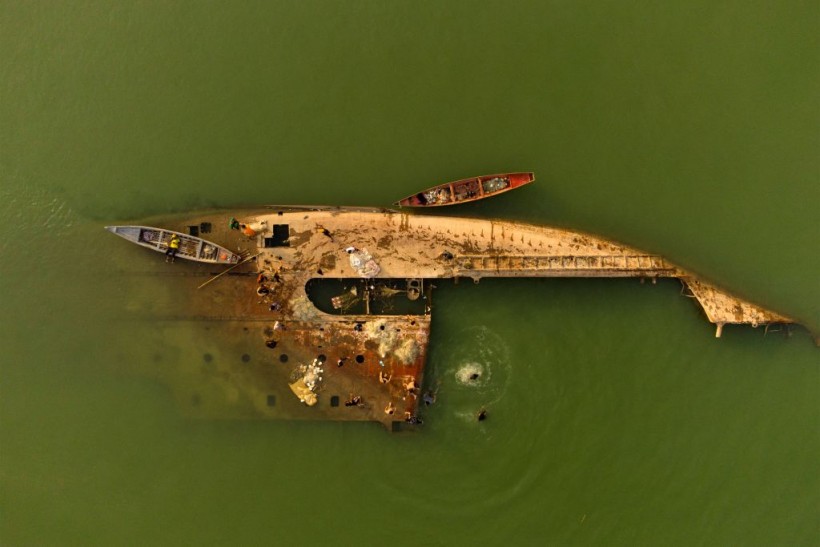Archaeologists uncovered the remains of a strange ship that may be one of Norway's first shipwrecks while looking for tons of munitions that had been placed on the bottom of a lake close to Oslo, according to a report by Live Science.
The wooden ship's 33-foot (10-meter) long hull is visible in Lake Mjøsa at a depth of approximately 1,350 feet (410 m), according to sonar scans.

(Photo : HUSSEIN FALEH/AFP via Getty Images)
An aerial picture taken by drone shows youths swimming in the Shatt al-Arab waterway, formed at the confluence of the Euphrates and Tigris rivers, near a shipwreck in Iraq's southerncity of Basra on June 6, 2022
"Clinker-built" Ship
According to Øyvind Ødegård, a maritime archaeologist at the Norwegian University of Science and Technology (NTNU), the ship was likely built up to 700 years ago, shortly after medieval designs with a distinct bow and stern began to replace Viking ships.
The sonar images highlight the distinctive frame of a "clinker-built" ship, a traditional Norse boatbuilding method, a classic Norse boatbuilding technique in which the planks of the hull overlap to make the hull lighter.
That technique was abandoned during the Medieval era in favor of the stronger "carvel-built" ships invented in the Mediterranean, as per Live Science.
NTNU and the Norwegian Defence Research Establishment (FFI) are working together on a project to find and map the hundreds of munitions that were dumped in Lake Mjøsa during the 1940s and 1970s.
The lake has been an important trading route connecting wealthy settlements at least since the Viking Age (the eighth to the eleventh centuries). Ødegård said that the prospect of discovering ancient artifacts in the lake's depths attracted the team.
Read Also: Archaeologists Discover Signs of Ancient Human Civilization in the Depths of Lake Constance
Autonomous Underwater Vehicle
With the aid of the FFI's Hugin autonomous underwater vehicle (AUV), about 15 square miles (40 square km) of Lake Mjøsa more than 140 square miles (360 square km) have been recorded.
The AUV is equipped with sonar, or sound navigation and ranging tech, which creates precise acoustic images of its surroundings even in nearly lightless conditions by using the reflections of sound pulses.
A three-dimensional reconstruction of the wreck has been created using several acoustic images from the AUV.
The ship would have had a single mast and a square sail, similar to a Viking ship, according to Ødegård, but it also appears to have had a central rudder instead of the conventional Viking rudder on the right side of the hull.
Even though similar-sized and constructed ships were presumably frequent on Lake Mjøsa throughout the Middle Ages, the archaeologists won't be able to identify the vessel's function until they can examine it with cameras.
According to Ødegård, the lake may contain even more ancient wrecks since it is the ideal location for discovering a Viking shipwreck in Norway.
Related Article: Archaeologists Discover Earliest Evidence of Cooking 780,000 Years Ago in the Jordan River
This article is owned by Tech Times
Written by Jace Dela Cruz









